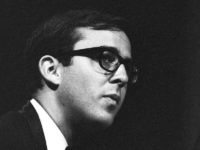He was a jazz organist also known as Khalid Yasin, but most everyone called him Larry. He was, in fact, the John Coltrane of the organ.
Seems for every Charlie Parker bebop innovator on an instrument, there was also a Coltrane figure who took it beyond bop. For example, Milt Jackson might be considered the vibraphone's Charlie Parker while Bobby Hutcherson is its John Coltrane. Bud Powell and Bill Evans on piano. Kenny Clarke and Tony Williams on drums. And so on.
Which brings us to organ. If Jimmy Smith was the Hammond B3's Bird, Larry Young could surely be considered its Trane. While Young started out at the dawn of the sixties sounding much like Smith (as have every other organist by then), by the middle of the decade he was getting away from the greasy, soul-jazz of Smith and adapting Coltrane's modal experiments to the instrument.
As any casual Young fan will tell you, he achieved modal organ nirvana on his 1965 masterpiece Unity, one of the finest Blue Note releases ever. Consisting of a quartet of Young joined by Joe Henderson, Woody Shaw and Elvin Jones, young assembled an eager, sympathetic group of first-rate players (Elvin being borrowed from J.C's band for this session). The name of the album was inspired by the unusually high level of interplay among the participants; everyone seems to be listening as much as playing. In particular, Jones and Young seems to be reading each other's minds like open books.
Unity was also buttressed by a strong set of songs; four of these six compositions were originals by band players. More to the point, the twenty year old trumpeter Shaw contributed three of them. One of them, "The Moontrane," is deserving of its own spotlight.
"The Moontrane" had gradually attained standards status in the jazz canon and it's easy to understand why. Like Coltrane's "Moment Notice," Shaw manages to craft a tune that's both harmonically advanced and deeply rooted to traditional jazz at the same time. It swings hard, even as it modulates from a brief, foreboding intro to a toe-tapping blues-based theme. And yet, the compelling chord progression of the chorus creates great soloing opportunities, of which Shaw, Henderson, Young and Jones all take great advantage.
As previously noted, Woody Shaw was just twenty years old when the premiere version of his song was recorded. But he had written the tune around the age of eighteen! Shaw had shown astonishing maturity to write such a composition in his teens that many highly regarded songwriters never quite achieved. And the true mark of a great composition is how fresh it sounds many years later and how well it lends itself to other musicians' interpretations.
I heard it more recently as performed by John LaBarbera's Big Band on Fantazm, and it still struck me as a nice cover choice (especially for a big band, truth be told). The song was also tackled by such luminaries as Dexter Gordon, Freddie Hubbard, Arturo Sandoval, Charles Earland and Woody Shaw himself.
Not bad coming from someone who was much better known as a brilliant trumpet player. From a technical standpoint, Shaw would be in my top three list, easily, but that's for another topic.
Getting back to Young, however, it took a leader who had the acumen to gave his bandmates the room to contribute both the musicianship and songs to make Unity a singular achievement. It was his team-oriented approach that not only brought Shaw's magnificent song "The Moontrane" to the world, but also made the first version of the song perhaps the best one of all.
- Nick Millevoi – ‘Moon Pulses’ (2024) - April 23, 2024
- Cannonball Adderley – ‘Poppin’ in Paris: Live at L’Olympia 1972′ (2024) - April 20, 2024
- Christian Marien Quartett – ‘How Long Is Now’ (2024) - April 18, 2024




